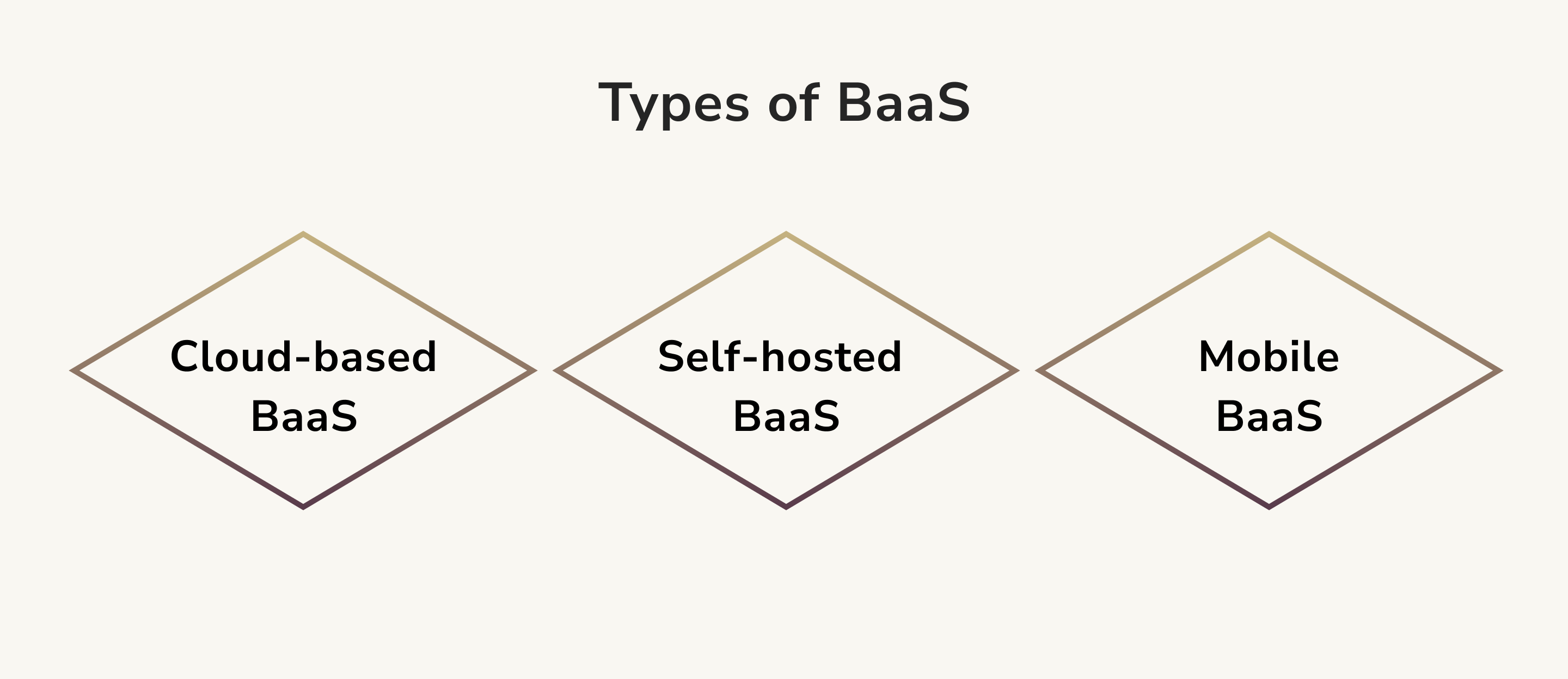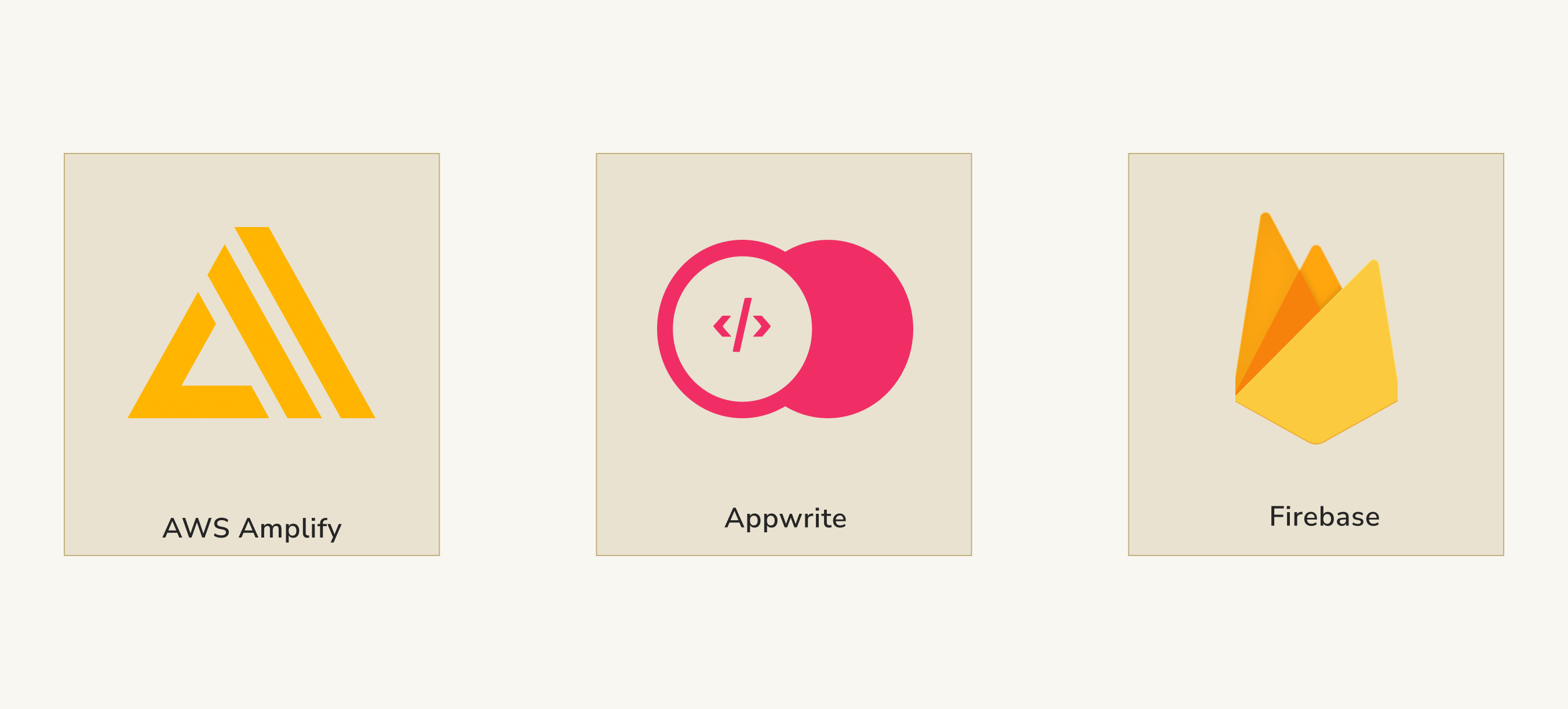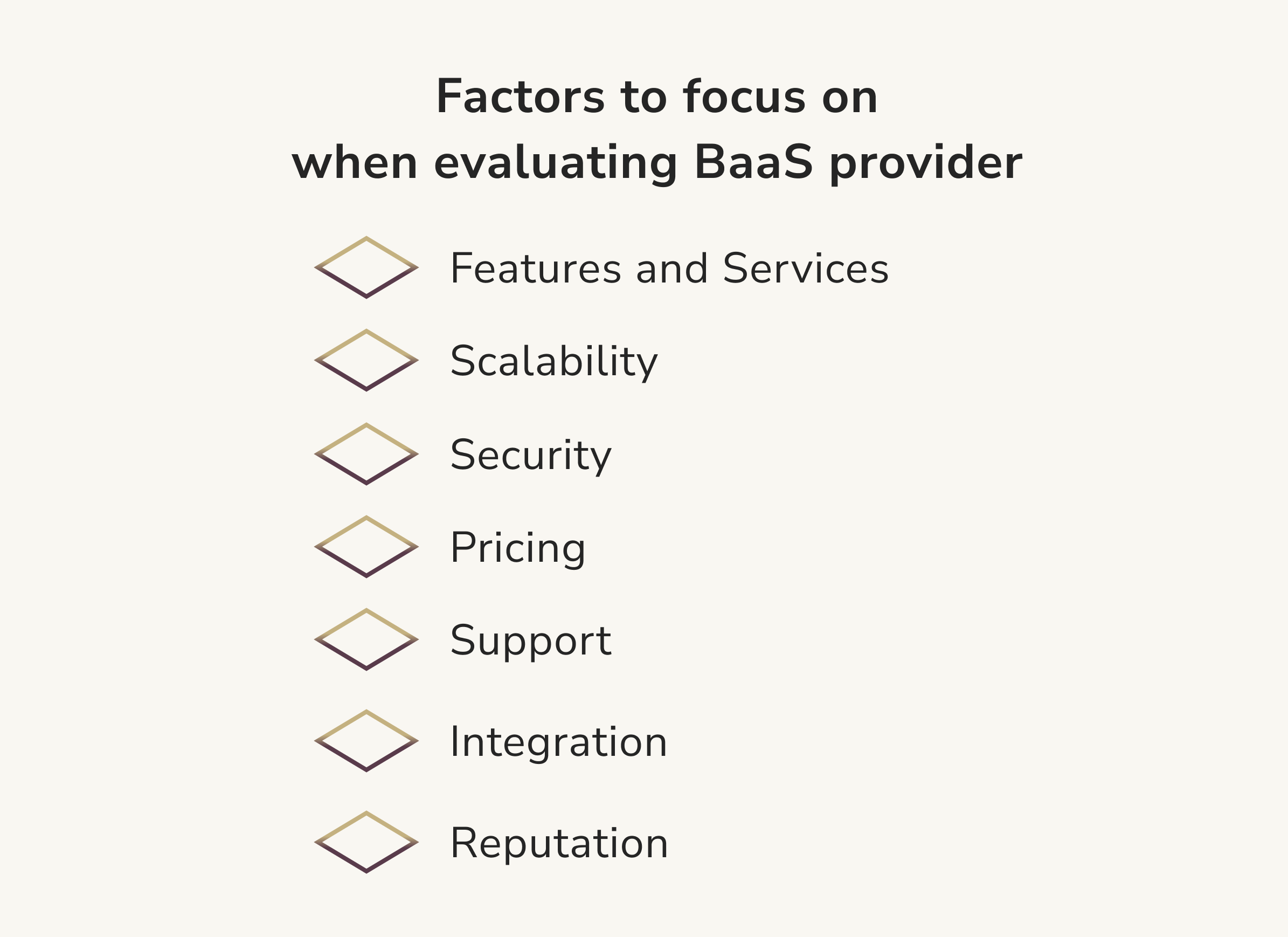Brief Guide to BaaS (Backend as a Service)

According to Future Market Research, the Backend as a Service (BaaS) market is expected to reach $22 billion by 2032, a major increase from its current value of $2.4 billion. At this point, the market's rise indicates that many companies will adopt the approach. Yet, to use a platform as a service model, it is crucial to understand the phenomenon from different perspectives.
At this point, one should focus on different types of BaaS, explore the distinct benefits of this approach, determine the examples of BaaS providers, and find out how to choose a BaaS provider. In addition, we will pay certain attention to comparing different models, including BaaS vs. FaaS, BaaS vs. SaaS, BaaS vs. PaaS, and BaaS vs. IaaS.
What is Backend as a Service (BaaS), and How Does it Work?
BaaS is a cloud-computing approach offering a backend for mobile applications. In a nutshell, this method provides an API and instrument for various computer languages to integrate with their backend. In addition, BaaS exists to provide some crucial services, such as storage, push notifications, analytics, dashboards, and social integration.
While BaaS is similar to Software as a Service (SaaS), BaaS is most often targeted at developers. In turn, SaaS focuses on end-users. BaaS is often recommended as the solution allowing stable and fast backend development to improve the app’s performance. With BaaS, you do not need to build the backend from scratch. In turn, you can leverage SDKs, APIs, and other existing tools to build a backend that can be scaled.
In the best-case scenario, when you have a backend provided by a BaaS platform, there is no need to spend too much time maintaining the backend. You can now focus on bettering the user experience or adding features to your app. What is more, BaaS provides features one can deploy across all application types. For instance, consider these approaches:
- SQL and NoSQL scalable databases. BaaS often provides scalable database solutions capable of handling vast amounts of data.
- Graph and REST APIs. BaaS also offers APIs enabling developers to make custom frontend applications that can easily communicate with the backend servers.
- Business logic through cloud code functions. BaaS provides cloud code functions presenting developers with the capabilities of adding custom business logic to the apps without needing a dedicated backend server.
- User authentication. BaaS offers authentication services that enable developers to quickly add user authentication to their applications. This includes login, sign-up, and password reset functionalities.
- Email verification. BaaS services typically provide email verification services to ensure user accounts are valid and authenticated.
- Social integration with different social media platforms. BaaS services offer social integration features that allow developers to integrate their applications with popular social media platforms like Facebook, Twitter, LinkedIn, etc.
- Push notifications. BaaS provides push notification services that enable developers to send notifications to their users in real-time.
- Geolocation. BaaS offers geolocation services that enable developers to add location-based functionality to their applications.
- Database Graphical User Interface (GUI). BaaS services typically provide a graphical user interface for managing the database, which makes it easier for developers to manage their database.
- Logs. BaaS services provide logging features that enable developers to monitor the application and track any errors or issues.
- CDN and cache. BaaS services provide content delivery network (CDN) and cache services that enable fast and efficient data delivery to the users.
- Infrastructure. BaaS services provide infrastructure services such as security settings, auto-scaling, data backup, and database optimization, which ensure the reliability and security of the application.
At this point, it is crucial to understand how one can use BaaS. Here's how BaaS typically works:
- Developers sign up for a BaaS provider's service and create an account.
- The BaaS provider offers a set of APIs and SDKs that developers can use to integrate the backend infrastructure into their applications.
- Developers use these APIs and SDKs to connect their applications to the BaaS provider's backend infrastructure. This allows their applications to perform various backend functions like data storage, user management, push notifications, and more.
- The BaaS provider manages the backend infrastructure, including server maintenance, scalability, and security, allowing developers to focus on their core application functionality.
- Developers can easily scale their applications as needed by adjusting the BaaS provider's infrastructure usage.
Overall, BaaS allows developers to outsource the development and management of their backend infrastructure to a third-party provider, freeing up time and resources to focus on the core functionality of their applications.
Types of BaaS
Now, let’s take a closer look at various types of BaaS. Discerning between these types is important for choosing the approach that works for your particular case.
Cloud-Based BaaS
Cloud-based BaaS is a popular type of BaaS solution that is hosted in the cloud. Developers can access the BaaS platform through a web interface or APIs and can take advantage of the pre-built features and services provided by the BaaS provider. The BaaS provider manages the platform's infrastructure, security, and scalability.
Self-Hosted BaaS
Self-hosted BaaS is a BaaS solution installed on a developer's servers or cloud infrastructure. Developers have more control over the platform and can customize it to meet their specific requirements. However, they also manage the platform's infrastructure, security, and scalability.
Mobile BaaS
Mobile BaaS is a BaaS solution specifically designed for mobile applications. It provides features and services optimized for mobile devices, such as push notifications, user authentication, and location-based services. Mobile BaaS can be cloud-based or self-hosted, depending on the developer's needs.

Benefits of BaaS
It is apparent that businesses choose BaaS not only because it is an innovative approach to managing the backend. In reality, there are some notable benefits to the phenomenon, the ones we will discuss below.
Ease of Use and Flexibility
BaaS presents an easy-to-use interface, which simplifies backend infrastructure management for developers. Besides, BaaS offers various backend infrastructure services that developers can choose from, including data storage, user authentication, push notifications, and more. This allows developers to select the services that best meet their needs and requirements, providing flexibility and customization options.
Greater Development Speed
BaaS significantly accelerates development speed by providing pre-built backend infrastructure, ready-to-use APIs and SDKs, and rapid prototyping capabilities. By outsourcing the backend development to a BaaS provider, developers can save time and resources that would have been spent on building a custom backend infrastructure from scratch. This allows them to focus on developing core application functionality, which helps ensure the application meets user needs and requirements.
Furthermore, BaaS providers offer a scalable and secure infrastructure, which can accommodate large volumes of data and traffic, allowing the application to grow without the need for additional backend development. BaaS can help accelerate development speed, allowing developers to get applications to market faster.
Reduced Time-to-Market
BaaS reduces time-to-market by providing a pre-built and ready-to-use backend infrastructure that developers can quickly integrate into their product during mobile or web application development. This eliminates the need to build a custom backend infrastructure from scratch, which can significantly reduce development time. BaaS providers offer a set of APIs and SDKs that developers can use to easily connect their applications to the backend infrastructure, making it easy to prototype and iterate on application development.
This helps developers quickly test and refine their applications, ensuring they meet user needs and requirements before launch. By reducing development time and streamlining the development process, BaaS can help developers to bring their applications to market faster, giving them a competitive advantage in their industry.
Cost-Reduction
BaaS can help reduce costs by eliminating the need for developers to build and maintain their own custom backend infrastructure. BaaS providers offer pre-built infrastructure that developers can quickly integrate into their mobile or web applications using a set of APIs and SDKs, significantly reducing the time and effort required for backend development.
By outsourcing the backend development to a BaaS provider, developers can save on the cost of hiring specialized backend developers and reduce ongoing maintenance costs. Additionally, BaaS providers offer a scalable infrastructure that can accommodate large volumes of data and traffic without the need for additional backend development or infrastructure investment. Overall, BaaS can help reduce costs and provide cost predictability for application development.
Focus on the Core Business Functions
BaaS allows developers to outsource the development and management of their backend infrastructure, freeing up time and resources to focus on the core functionality of their applications. This enables developers to focus on the key features that differentiate their products in the market and deliver business value.
At this point, BaaS is a great way of prioritizing different business functions and operations. While the platform handles the backend, you can have developers working on top-priority tasks and doing everything possible for your product to stand out.
Standardize Backend Development
BaaS providers offer pre-built backend infrastructure and APIs, which can help standardize backend development. This can make it easier for developers to collaborate on backend development and reduce the time and effort required to build a custom backend.
Respectively, with standardized backend development, it does not matter how many new developers you hire, each new employee will know how to use the platform based on the standard rules and descriptions.
Focus on User Experience (UX) and Frontend Development
BaaS can help developers to focus on User Experience (UX) and frontend development, allowing them to create a compelling user experience and differentiate their product in the market. The backend is only one part of the deal. In reality, you need your app to have both a great frontend and backend.
These two approaches ensure your product is both appealing and functional. Besides, this means even with a UI/UX that needs a lot of potency and resources, your app will be stable and handle multiple user requests. At this point, one of the key benefits BaaS provides is improving overall product development.
Emphasizing High-Value Lines of Code
With BaaS, developers can focus on writing high-value lines of code that differentiate their products and provide business value rather than spending time on building custom backend infrastructure.
Keep in mind that not all code is born equal. There will be lines of code one can easily find on GitHub. However, there will also be lines of code that require hundreds of hours of input and even more hours of editing. BaaS gives you more time and effort to focus on the code that delivers instead of the code that can be easily found.
Cross-Platform Development
BaaS presents cross-platform development capabilities, enabling developers to create applications that can run on multiple platforms, including mobile and web. In other words, if you work with React and some similar programming languages, it is better to use BaaS, namely because you will have a platform that can handle the capabilities cross-platform app development requires.
Faster Feedback Reactions
Finally, BaaS offers rapid prototyping capabilities, allowing developers to test and refine their applications quickly. This enables faster feedback reactions and ensures the application meets user needs and requirements. With feedback delivered to you at a greater speed, you can work out crucial updates and make the product better in almost no time.
There are enough reasons to look at BaaS as a potential tool in the context above. When you know the benefits of the approach, it is time to discover some examples of BaaS providers worth choosing from.
Examples of BaaS Providers
There is nothing better than seeing how BaaS works within the context of providers. Now, let’s look at some industry’s frontrunners to find out what a good BaaS provider looks like.

Firebase
Firebase is a leading BaaS platform backed by Google. Founded in 2011, over the years, Firebase managed to get a reputation as a top-performing provider. Remember that the platform is used by some notable businesses like the New York Times, Gameloft, Duolingo, and Alibaba.
Firebase comes with these standalone features:
- Cloud storage
- Cloud functions
- Real-time database
- Hosting
- Analytics
- Performance monitoring
With these features, Firebase comes at the forefront of the BaaS industry.
AWS Amplify
AWS Amplify is a well-known BaaS platform delivered by Amazon. With this platform, you can easily configure web and mobile app backends. The best part of handling AWS is that you do not need any expertise to tap into the cloud-based backend. Companies like HyperTrack, Noom, and Amazon Music are built on AWS Amplify BaaS.
AWS Amplify comes with these standout features:
- Cloud analytics
- Authentication
- Lambda functions
- Amplify hosting
- Cloud DataStore
These aspects help the platform deliver a top-notch user experience and make the backend as good as it gets.
Appwrite
Appwrite is another BaaS provider to mention. It is an open-source hosted BaaS platform providing access to REST APIs. This provider helps handle all your software product's core backend needs. Appwrite can run on any operating system or programming language as a technologically agnostic platform. This means the BaaS provider is flexible and versatile.
Appwrite provides services with these key features:
- Cloud-based databases
- Cloud storage
- Cloud functions
- Geo and localization
- Top-grade encryption
With the features above, the platform delivers services many of its clients are pleased to use. In such a case, the examples of providers above set a baseline of what you should look for. To get what the best BaaS practices offer, you need to know what you are looking for in the first place.
How to Choose a BaaS Provider?
When choosing the top-performing BaaS provider, focusing on several key aspects is crucial. Without further ado, consider these seven factors:
- Features and Services. Different BaaS providers offer different features and services. You should evaluate the features and services each BaaS provider presents and choose the one that best fits your project requirements. For example, choose a BaaS provider offering real-time synchronization features if your application requires synching data in real-time.
- Scalability. It is an essential factor when choosing a BaaS provider. You should choose a BaaS provider that can handle your application's expected traffic and user load. You should also ensure that the BaaS provider scales up or down as your application grows.
- Security. It is critical when handling user data and application infrastructure. You should choose a BaaS provider that offers robust security features and ensures your application data is secure.
- Pricing. It is an essential factor to consider when choosing a BaaS provider. You should evaluate the different BaaS providers' pricing plans and choose the best fit for your budget. You should also consider additional costs, such as data transfer or API call fees.
- Support. It is critical when using a BaaS provider. You should choose a BaaS provider with good support and a team of experts available to help you with any issues or questions.
- Integration. It is an essential factor to consider when choosing a BaaS provider. You should choose a BaaS provider that integrates well with your existing development tools and technologies.
- Reputation. The reputation of the BaaS provider is also an essential factor to consider when choosing a BaaS provider. You should choose a platform with a good reputation and the trust of other developers and businesses.
Follow the factors above and choose the BaaS provider meeting your needs. Naturally, while the aspects we mentioned work in most cases, if you need some tailored-to-your-specific needs, there are some additional factors you need to consider and research.

BaaS vs. FaaS
When it comes to drawing the line between BaaS and other approaches like Function as a Service (FaaS), Software as a Service (SaaS), Platform as a Service (PaaS), and Infrastructure as a Service (IaaS), it is important to find several key points of comparison. At this point, we should focus on aspects like usage, architecture, development, flexibility, cost, purpose, and customization where applicable.
Architecture: BaaS provides a complete backend infrastructure for building applications. It includes databases, authentication, storage, and other features. In contrast, FaaS provides a serverless architecture where developers write and deploy functions executed in response to an event trigger without needing to manage the underlying infrastructure.
Usage: BaaS is ideal for building applications that require a complete backend infrastructure. It provides a set of pre-built APIs and services that can be used to build applications quickly. FaaS, on the other hand, is ideal for building event-driven applications, such as IoT and real-time data processing.
Development: BaaS makes development faster and more efficient by providing pre-built APIs and services and requires less coding. FaaS, in contrast, requires developers to write code for specific functions, which can take longer to develop.
Flexibility: BaaS provides limited flexibility since it comes with pre-built APIs and services. FaaS, on the other hand, is highly flexible since developers can write custom code for specific functions.
Cost: BaaS is generally more expensive than FaaS since it provides a complete backend infrastructure. FaaS, in contrast, is often cheaper since it only charges for the number of resources used for each function.
BaaS vs. SaaS
Purpose: BaaS is focused on providing backend infrastructure services such as databases, APIs, and other features, while SaaS provides a complete software application that runs on the cloud.
Usage: BaaS is used to build applications quickly by providing pre-built APIs and services. In contrast, SaaS provides complete software applications for specific use cases such as customer relationship management, human resource management, and more.
Customization: BaaS provides some level of customization for applications by allowing developers to integrate pre-built APIs and services into their applications. However, SaaS provides limited customization options as it is a complete software application with limited extensibility.
Development: BaaS provides some level of flexibility to developers by allowing them to use pre-built APIs and services, which makes development faster and more efficient. In contrast, SaaS requires developers to write custom code to add new features or functionalities, which can take longer to develop.
Cost: BaaS is generally more affordable than SaaS since it provides a limited set of backend infrastructure services. However, SaaS is often more expensive since it provides a complete software application with ongoing maintenance and updates.
BaaS vs. PaaS
Purpose: BaaS is focused on providing backend infrastructure services such as databases, APIs, and other features, while PaaS provides a complete platform for building and deploying applications.
Usage: BaaS is used to build applications quickly by providing pre-built APIs and services, while PaaS provides a complete platform for building, testing, and deploying applications.
Customization: BaaS provides some level of customization for applications by allowing developers to integrate pre-built APIs and services into their applications. PaaS, on the other hand, provides a high level of customization by allowing developers to write custom code and configure the entire platform.
Development: BaaS provides some level of flexibility to developers by allowing them to use pre-built APIs and services, which makes development faster and more efficient. PaaS requires developers to write custom code and configure the platform, which can take longer to develop but offers more flexibility.
Cost: BaaS is generally more affordable than PaaS since it provides a limited set of backend infrastructure services. PaaS, on the other hand, is often more expensive since it provides a complete platform with ongoing maintenance and updates.
BaaS vs. IaaS
Purpose: BaaS is focused on providing backend infrastructure services such as databases, APIs, and other features, while IaaS provides virtualized infrastructure resources such as servers, storage, and networking.
Usage: BaaS is used to build applications quickly by providing pre-built APIs and services, while IaaS provides a virtualized infrastructure to build and run applications.
Customization: BaaS provides some level of customization for applications by allowing developers to integrate pre-built APIs and services into their applications. IaaS, on the other hand, provides a high level of customization by allowing developers to configure the virtualized infrastructure per their needs.
Development: BaaS provides some level of flexibility to developers by allowing them to use pre-built APIs and services, which makes development faster and more efficient. IaaS requires developers to set up and configure the infrastructure, which can take longer to develop but offers more flexibility.
Cost: BaaS is generally more affordable than IaaS since it provides a limited set of backend infrastructure services. IaaS, on the other hand, can be more expensive since it provides virtualized infrastructure resources, and the cost can vary based on the number and types of resources being used.
Conclusion
BaaS is not a panacea. As you might see from the comparisons above, it is crucial to do some homework to understand which approach best meets the needs of your business or organization. Yet, equipped with the knowledge from this piece, it would be a bit easier to tap into BaaS and ensure it brings advantages to people using it.

Roman Zomko
Other articles